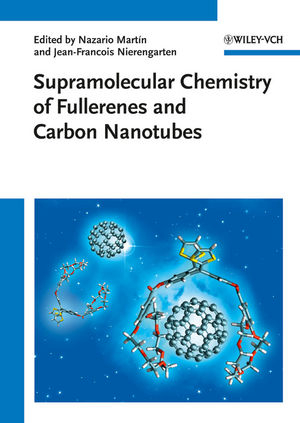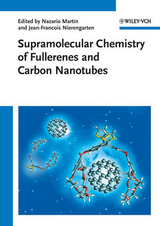Supramolecular Chemistry of Fullerenes and Carbon Nanotubes
Wiley-VCH (Verlag)
978-3-527-32789-8 (ISBN)
- Titel ist leider vergriffen;
keine Neuauflage - Artikel merken
Collating our current knowledge and the latest developments for enabling breakthrough discoveries, this book focuses on the synthesis and applications of materials that are based on supramolecular assemblies of carbon nanostructures, with an emphasis on fullerenes and nanotubes. In so doing, it provides readers with an overview of the different types of supramolecular architectures, accentuating the outstanding geometrical, electronic and photophysical properties of the building blocks and the resulting structures. It makes use of basic concepts and real-life applications -- from simple syntheses to complex architectures, from instructive examples to working experimental procedures, and from photophysics to solar cells. A large part of each chapter is devoted to the methods and possibilities of controlling and tuning these molecular assemblies in order to obtain working devices.Fascinating reading for materials scientists, organic chemists, molecular physicists, and those in the semiconductor industry.
Nazario Martín is full professor of Organic Chemistry at the University Complutense of Madrid and vice-director of the Institute for Advanced Studies in Nanoscience of Madrid (IMDEA-Nanoscience). Professor Martín's research interests span a range of targets with emphasis on the molecular and supramolecular chemistry of carbon nanostructures such as fullerenes, endofullerenes, carbon nanotubes and graphenes, ¿-conjugated systems as molecular wires and electroactive molecules, in the context of electron transfer processes, photovoltaic applications and nanoscience. He has published over 400 papers in peer reviewed journals, and he has co-edited six books related with carbon nanostructures, and eight special issues as guest editor in well-known international journals. He is a member of the editorial and international advisory board of prestigious international journals. He is a fellow of The Royal Society of Chemistry and the President of the Spanish Royal Society of Chemistry (2006-2012). Jean-François Nierengarten is a CNRS Researcher (Directeur de Recherche) at the University of Strasbourg, France. His research interests range from covalent and non-covalent chemistry of fullerenes to dendrimers and pi-conjugated systems with unusual electronic and optical properties. Jean-François Nierengarten has received numerous awards, including the bronze medal of the CNRS, the SFC-ACROS prize from the Organic Chemistry Division of the French Chemical Society and the Grammaticakis-Neumann Prize from the French Academy of Science. He is currently the Secretary of the Fullerenes, Nanotubes and Carbon Nanostructures Division of the Electrochemical Society and a fellow of the Royal Society of Chemistry.
PREFACE
CARBON NANOSTRUCTURES: COVALENT AND MACROMOLECULAR CHEMISTRY
Introduction
Fullerene-Containing Polymers
Carbon Nanotubes
Graphenes
Summary and Conclusions
HYDROGEN-BONDED FULLERENE ASSEMBLIES
Introduction
Hydrogen-Bonded Fullerene-Based Supramolecular Structures
Hydrogen-Bonded Fullerene-Based Donor?Acceptor Structures
Applications
RECEPTORS FOR PRISTINE FULLERENES BASED ON CONCAVE - CONVEX pi - pi INTERACTIONS
Introduction
Fullerene Receptors Based on Traditional Hosts
Hydrocarbon Receptors
Receptors Bearing a Curved Conjugated System
Conclusions
COOPERATIVE EFFECTS IN THE SELF-ASSEMBLY OF FULLERENE DONOR ENSEMBLES
Introduction
Allosteric Cooperativity
Chelate Cooperativity
Conclusions
Experimental Details
FULLERENE-CONTAINING ROTAXANES AND CATENANES
Introduction
Fullerene Rotaxanes and Catenanes
Conclusions
BIOMIMETIC MOTIFS TOWARD THE CONSTRUCTION OF ARTIFICIAL REACTION CENTERS
Introduction
Supramolecular Architectures for Solar Energy Conversion
Outlook
SUPRAMOLECULAR CHEMISTRY OF FULLERENE-CONTAINING MICELLES AND GELS
Introduction
Solubilization of Pristine C60 in Surfactant Assemblies
Self-Assemblies of Amphiphilic C60 Derivatives
Gels of Fullerenes
Conclusions and Outlook
FULLERENE-CONTAINING SUPRAMOLECULAR POLYMERS AND DENDRIMERS
Introduction
Fabrication of [60]Fullerene Polymeric Array
Supramolecular Polymerization of Functionalized [60]Fullerene
Supramolecular [60]Fullerene Dendrimer
Conclusions
[60]FULLERENE-CONTAINING THERMOTROPIC LIQUID CRYSTALS
Introduction
Noncovalent C60 Derivatives
Covalent C60 Derivatives
Conclusions
SUPRAMOLECULAR CHEMISTRY OF FULLERENES ON SOLID SURFACES
Introduction
Fullerenes on Nonpatterned Metal Surfaces
Surface Templates for Fullerene Adsorption
Supramolecular Aggregation of Fullerenes and other Organic Species on Surfaces
Outlook
SUPRAMOLECULAR CHEMISTRY OF CARBON NANOTUBES
Introduction
Supramolecular Carbon Nanotube Hybrids
Conclusions
SUPRAMOLECULAR CHEMISTRY OF FULLERENES AND CARBON NANOTUBES AT INTERFACES: TOWARD APPLICATIONS
Introduction
Fullerene Interfaces
Carbon Nanotubes
Conclusions
APPLICATIONS OF SUPRAMOLECULAR ENSEMBLES WITH FULLERENES AND CNTS: SOLAR CELLS AND TRANSISTORS
Introduction
Solar Cells
Transistors
Summary
EXPERIMENTAL DETERMINATION OF ASSOCIATION CONSTANTS INVOLVING FULLERENES
Planning a Titration Experiment
Performing a Titration
Choosing the Spectroscopic Method
Analyzing the Data
Determining Stoichiometry
Estimating Errors
Fullerenes as Guests: Spectroscopic Properties
Determination of the Binding Constant of an exTTF-based Host toward C60: A Practical Example
Conclusions
| Erscheint lt. Verlag | 23.4.2012 |
|---|---|
| Verlagsort | Weinheim |
| Sprache | englisch |
| Maße | 170 x 240 mm |
| Gewicht | 920 g |
| Themenwelt | Naturwissenschaften ► Chemie ► Anorganische Chemie |
| Naturwissenschaften ► Chemie ► Organische Chemie | |
| Technik ► Maschinenbau | |
| Schlagworte | Chemie • Chemistry • Electronic materials • Elektronische Materialien • Fullerene • Kohlenstoffnanoröhrchen • Kohlenstoffnanoröhren • Materials Science • Materialwissenschaften • Nanomaterial • Nanomaterialien • nanomaterials • Nanostrukturiertes Material • Nanotechnologie • nanotechnology • supramolecular chemistry • Supramolekulare Chemie |
| ISBN-10 | 3-527-32789-4 / 3527327894 |
| ISBN-13 | 978-3-527-32789-8 / 9783527327898 |
| Zustand | Neuware |
| Informationen gemäß Produktsicherheitsverordnung (GPSR) | |
| Haben Sie eine Frage zum Produkt? |
aus dem Bereich




